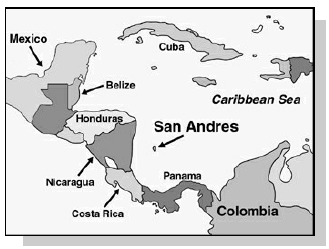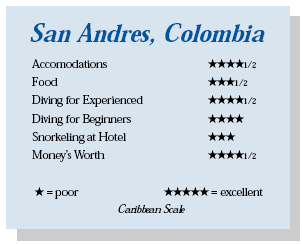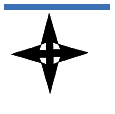San Andres Island, Almost NicaraguaContents of this Issue: San Andres Island, Almost Nicaragua Those Chilly Second Dives: A Cause and Solution? Dripping Ceilings, Peanut Allergies, an Honest Man Chain Stores, Catalogues, and the Internet : The Future of Dive Shops? That Solo Diving Certification $35 Million Suit Filed in Diving Death Editorial Office: Ben Davison Publisher and Editor Undercurrent 3020 Bridgeway, Suite 102 Sausalito, CA 94965 where Americans fear to tread from the May, 2002 issue of Undercurrent
Dear Fellow Diver: Ninety miles off the coast of Nicaragua, in the southwestern Caribbean, lies an island about sixteen square miles -- less than one-fifth the size of Bonaire -- yet it sports upwards of 60,000 people, six times the population of Bonaire. The island, San Andres, is a highly developed international tourist destination. Were it part of Nicaragua it would no doubt be populated with American tourists. However, while Nicaragua lays claim to it, it is Colombia’s territory. English is widely spoken, about 15,000 students attend college there, the streets are safe and seemingly drug-free, and tourists from Europe, Canada, and South America play on its beaches and dive its waters. And to find an American is nigh impossible. Except for myself (though most everyone thought I was
German; it didn’toccur that an American would be visiting),
during late February. And from several standpoints it was
surely worth the trip, though it took nearly a month for my
travel agent to organize the journey, thanks to a combination
of “manana” and “island time” attitudes from the
tourist industry there. It’s not easy to reach from the U.S.
Direct charter flights depart from Toronto and Avianca flies
from Bogota. I departed from San Jose, Costa Rica, but not
without a hassle. At the Costa Rica airport, West Caribbean
Airways had no tickets for me, though I had prepaid and was
supposed to pick them up. I paid a second time: $248. At
San Andres’ Hotel Decameron Aquarium, there was no record of
my reservation or prepayment. I pulled out my credit card.
The dive operator had no record of my prepaid reservations.
Again, I pulled out my credit card. While I could have gone
ballistic, I exercise patience in foreign lands. It was just
the thing to do. The Diver’s Dream office is in the hotel lobby, while the dive shack itself is at the end of a 300-foot pier, along which sun worshipers recline under umbrellas. One can rent plenty of water toys at the watersports shop, get a meal at El Bruja, the seafood restaurant, or a drink at the bar. The two-room dive shop building houses the compressors, tanks, and a place to stow dive gear. The dive company runs at least three unshaded eighteen-foot skiffs, with twin Yamaha outboards. The boat holds twenty aluminum 80s, which they pump to 3100+ psi. The boat driver and divemaster put your tanks with BC in the boat and the rest is up to you. The first morning, I arrived forty-five minutes before the 9:00 A.M. shove-off time, but the morning boat had already pulled out! Seasoned travel that I am -- it might not seem like it by now -- I had failed to realize that San Andres is on Colombian time (EST) rather than Costa Rican time (CST). I was an hour late. I took a walk, read a book, and watched a fuzzy CNN in my hotel room before taking an afternoon boat dive with a Canadian couple taking an intro class. Our divemaster was a zero-body-fat young guy with a blond pony tail named Sebastian. Like all Diver’s Dream staff, he spoke adequate English. A shallow site called La Piramide (the pyramids) two minutes east of the hotel is a group of small coral reefs surrounded by sand at thirty feet. In the 81-degree water (it stayed the same at all depths), hordes of yellowtail snappers and sergeant majors surrounded me. The visibility ran eighty feet, as it did just about every dive. I found wrasse cleaning stations, Spanish hogfish, a goldentail moray, schools of spotted and yellow goatfish, and large schools of Cesar grunts and Creole wrasse. A southern sting ray allowed me in close for photos. While the dive was to last forty-five minutes, Sebastian had such a good time interacting with the fish that he and I stayed down for eighty minutes. Overall a typical first Caribbean dive, no doubt where fish are fed and tyros tune up. The next day, the professional and helpful Jorge Gomez led us to El Pargocillo, where a bottomless wall begins at sixty feet. We had to pull ourselves down the anchor line through a strong surface current, which lasted to 100 feet. I spent much of the dive hanging onto any dead coral I could find, unable to photograph the hordes of Midnight Parrot fish and Rainbow Parrot fish. Like most of the reefs, it was covered with very lush gorgonions. Still, it was a bum dive because it should have been a drift -- as most were for the rest of my stay. I guess the decision whether to anchor or drift rests with the day’s leaders. Coral View is a beautiful and accessible bottomless wall starting at thirty feet. The coral and large, remarkable-looking sponges were healthy, even down to 160 feet. At 130 feet a trumpetfish closely shadowed a big tiger grouper. Like most sites there were lots of clusters of pretty pillar coral, all covered with fuzzy tentacles even during the day. A scheduled, afternoon dive was scratched because one of the two Yamahas on the one available boat was down. I did the two morning dives with Nelson Ramos, an instructor whose specialty seems to be puns that left everyone groaning. At West Point, a twenty-minute boat ride, we drifted in mild current along a mini-wall at sixty-five feet, then dropped to the real wall at 130 feet. Between dives, we motored to a small oceanside café for fruit drinks. Then off to Bajo Bonita for an easy drift along coral bommies extending up from the fifty-foot sand bottom, where a six-foot green moray came out of his hole to check us out. That afternoon, David Guggenheim, a younger version of Sebastian, took us to Nirvana, where the variety of animals and the diverse shape and variety of the corals made it the best dive that I had on the trip. There is a sunken fishing boat on the sand at fifty feet that can be penetrated. At 100 feet I found a three-inch long snouted butterflyfish, a critter only found deep. The Aquarium is the largest of four Decameron hotels on San Andres. A gated community with guards at all of the entrances, it has a nice private beach. My package -- room, all drinks, including booze, and meals -- ran $95/day (and there are cheaper packages). The 270 rooms are in fifteen three-story towers (no elevators) with six rooms on a floor. Each trapezoidal room has an outer wall of glass with a covered twentyfoot- wide balcony directly over the lagoon. From one side of my balcony, I looked over the Caribbean and from the other side I faced three large seawater pools. The hotel towers are built in the lagoon, so you can even snorkel around them. The hotel offers small sailboats, paragliding, windsurfing, kayaking, jetskis, snorkeling, and swimming trips to surrounding cays to keep you busy. In several protected lagoons people played water volleyball, snorkeled, sailed, and windsurfed. Stretching over the ocean were hundreds of feet of walkways, where sun lovers -- many topless -- soaked up rays and socialized. La Barracuda, the large indoor air-conditioned restaurant, has a covered outdoor building with breezes, ocean views, and an open area of tables under many palm trees,. It, El Bruja on the dock, and an Italian restaurant above the lobby served mediocre dinners, but breakfast and lunch were fine. I walked a half mile to La Regatta, along an irregular sidewalk, past modern high-rises and small business complexes intermixed with the weed-choked remains of old buildings that were incompletely torn down, and a plethora of shops, bars, and restaurants to serve the tourists and pleasure seekers. Built over the ocean, La Regatta had plenty of tables filled with fun-loving European tourists. For my free meal, which otherwise would have cost about $40, I ordered a superb shrimp cocktail, crab soup, salad, rare medallions of beef, which were perfectly prepared, coffee, and dessert. Back at the hotel, I sat in the shadows to watch the nightclub entertainment provided alongside the pool until 11:00 P.M. One can watch or participate in activities far more salacious than would be found in a tourist hotel in most other places. A game like “Weakest Link” and other opportunities provided ample opportunities for people to have a great time or get loaded and make fools of themselves, depending how you view these things. One watering hole, El Plunge, had barstools both in the adult pool and a longside . But of course I was here for the underwater scene. As a longtime diver, I
relished the feeling of “diving in the 1980s,” when no one required buddy diving,
set maximum depth limits, or forbid reverse profile dives. If you had a beer or
glass of wine with your lunch, no one would know or care. No one asked my maximum
depth, much less whether I had gone into deco. To be clear about the fish life, there were lots of friendly queen and gray angels, as well as shy French angels and rock beauties. There were four-eye and striped butterflyfish, a couple of nurse sharks, large green morays, and a couple of goldentail morays. There were plentiful trumpetfish, scrawled filefish, yellowfin and tiger groupers, barjacks, schoolmasters, schools of Bermuda chub, and of course grunts. Large midnight parrotfish, big rainbow parrotfish, sometimes in schools, and gangs of juvenile princess parrots. More balloonfish than usual. Lots of cowfish and trunkfish. No Nassau groupers, horse-eyed jacks, rainbow runners, hogfish, big snappers, or queen triggers. No great barracuda but small schools of southern sennet. I would rate the reefs superior to Roatan, and similar in quality to the best reefs in Belize (though San Andres had more bottomless walls and was prettier at 130). Also, the soft corals were much denser than in Belize. The sponges were among the best that I have seen in the Caribbean since I visited Little Cayman a decade ago. It also offers healthy shallow coral mounds (less than thirty feet deep) with no sign of any storm damage. San Andres is reportedly out of the hurricane belt and the pristine staghorn coral reflects that. Like the reefs of Los Roques in Venezuela, the reefs around San Andres resemble a rainforest with their dense covering of bushy seawhips, sea plumes, and many other gorgonions. Who should dive San Andres? My guess is folks who have been everywhere in the Caribbean and want to keep moving. People looking for an extension from Costa Rica after a live-aboard trip. Divers who want a calm, urban, international dive experience. Those who want to visit a Spanish-speaking country. Beyond that, who knows? But I enjoyed it, a jaded fellow with a thousand-plus dives worldwide. And if you’re among the groups I mentioned, you will too. -- T.A. |

I want to get all the stories! Tell me how I can become an Undercurrent Online Member and get online access to all the articles of Undercurrent as well as thousands of first hand reports on dive operations world-wide
| Home | Online Members Area | My Account |
Login
|
Join
|
| Travel Index |
Dive Resort & Liveaboard Reviews
|
Featured Reports
|
Recent
Issues
|
Back Issues
|
|
Dive Gear
Index
|
Health/Safety Index
|
Environment & Misc.
Index
|
Seasonal Planner
|
Blogs
|
Free Articles
|
Book Picks
|
News
|
|
Special Offers
|
RSS
|
FAQ
|
About Us
|
Contact Us
|
Links
|
3020 Bridgeway, Ste 102, Sausalito, Ca 94965
All rights reserved.

 Soon the hotel manager and the Gema Tours manager tracked me down, apologized
profusely for temporarily losing my
advance payments, saw to it I would
get my airline refund, and arranged a
complimentary dinner for me at an
excellent restaurant. The folks I
encountered elsewhere on the island
were just as pleasant.
Soon the hotel manager and the Gema Tours manager tracked me down, apologized
profusely for temporarily losing my
advance payments, saw to it I would
get my airline refund, and arranged a
complimentary dinner for me at an
excellent restaurant. The folks I
encountered elsewhere on the island
were just as pleasant. They made no effort to keep me with
divers undergoing certification and, with
one exception, I dived alone. I could have
been accompanied by a divemaster had I
asked. They did set bottom times at fortyfive
to fifty-five minutes, especially for
the second morning dive so we could be
back at the hotel for lunch. However, the
actual bottom times always ended up ten to
twenty minutes longer. (San Andres has a
recompression chamber with a trained technician).
They asked me to sign a waiver
printed in Spanish, which I signed without
asking for a translation -- don’t sign,
don’t dive. One negative about going back
in time was seeing the divemaster inflate
balloonfish for my amusement. They seemed
to think it was fun to force morays and
octopi out of their holes. I tried to
explain to them that harassing and stressing
critters was no longer considered kosher.
They made no effort to keep me with
divers undergoing certification and, with
one exception, I dived alone. I could have
been accompanied by a divemaster had I
asked. They did set bottom times at fortyfive
to fifty-five minutes, especially for
the second morning dive so we could be
back at the hotel for lunch. However, the
actual bottom times always ended up ten to
twenty minutes longer. (San Andres has a
recompression chamber with a trained technician).
They asked me to sign a waiver
printed in Spanish, which I signed without
asking for a translation -- don’t sign,
don’t dive. One negative about going back
in time was seeing the divemaster inflate
balloonfish for my amusement. They seemed
to think it was fun to force morays and
octopi out of their holes. I tried to
explain to them that harassing and stressing
critters was no longer considered kosher. Divers Compass: Flights from Costa Rica cover 240 miles and take
sixty-five minutes. The planes are fifty-passenger twin turboprops.
At Migracion, ask for a free visa extension, which will
reduce your exit tax from $50 to $26. I used Reef and Rainforest
in Sausalito, CA (800-794-9767 or
Divers Compass: Flights from Costa Rica cover 240 miles and take
sixty-five minutes. The planes are fifty-passenger twin turboprops.
At Migracion, ask for a free visa extension, which will
reduce your exit tax from $50 to $26. I used Reef and Rainforest
in Sausalito, CA (800-794-9767 or 